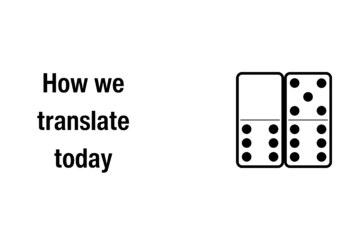How to translate design-based content

When it comes to translating content, not all file types are created equal. Design-heavy formats like Figma, Adobe FrameMaker, and InDesign bring their own set of challenges and opportunities to the translation process. Whether you’re dealing with UI (user interface) mock-ups, technical documentation, or marketing brochures, ensuring linguistic accuracy while preserving layout and design is key and saves valuable time and money.
Key considerations when translating design-based content
Translating content from design tools like Figma, Adobe FrameMaker, and InDesign involves more than just converting words from one language to another. These formats are deeply tied to layout, structure, and visual presentation, which means that every linguistic decision can have design implications. Here are some general factors to keep in mind when translating design-based content:
- Text expansion and contraction: When translating from English into languages like German, French, or Russian, text often becomes longer, sometimes up to 30% more. Conversely, translations into Chinese or Japanese may result in shorter text. These variations in length can lead to layout issues, such as text overflow or misalignment, so it’s essential to plan for flexible text containers and adjustable spacing in the original design.
- Preserving formatting and style: Design documents often rely on specific styles, fonts, and visual hierarchies to convey meaning. Translators working within CAT tools should be mindful of tags and formatting codes to avoid breaking styles or accidentally removing elements essential to the layout. Additionally, fonts used in the original design may not support certain scripts, such as Chinese characters, Cyrillic script, or other non-Latin alphabets, which may require font substitution or manual adjustments during layout review.
- Layered content and non-translatable elements: Design tools like InDesign, FrameMaker, and Figma often contain hidden layers, conditional text, or off-canvas elements that may unintentionally end up in translation exports. Examples of these elements include placeholder text, component names, or developer notes that aren’t meant to be translated. Without proper filtering, such content can increase word count and cause confusion. Pre-processing helps to make sure only visible, translatable content is sent to translation.
- Consistency across pages and languages: Design-heavy content often uses recurring phrases, headings, or structural elements. Maintaining consistent translations across pages and languages not only improves quality but also makes post-layout adjustments more predictable and efficient.
- Localised context: Some visuals or wording might not resonate across different cultures. Even though the layout remains the same, localisation teams should keep an eye on images, symbols, or copy that might require cultural adaptation to remain effective in other markets.
- Quality assurance (QA): Once the translated content is reimported into the original design file, a layout or visual QA step is essential. A native-speaking reviewer or localisation specialist should check for issues like incorrect line breaks, font rendering problems, text overflow, or broken layouts. This step ensures that the translated content not only reads well but also fits seamlessly within the design. It’s especially important for languages with different script systems or significantly longer text, where small layout shifts can have a big visual impact.
By considering these factors early on and choosing tools that support integration with localisation tools (CAT tools), you can avoid costly rework and ensure that multilingual versions of your materials are just as polished and functional as the original.
Translating InDesign: layout-centric publishing software
Adobe InDesign is the industry standard for creating print-ready documents such as brochures, reports, and marketing materials. In these documents, layout is just as important as the content itself. When translating these documents, the goal is not only to convey the message accurately but also to maintain the visual structure and design integrity.
For localisation workflows, content is typically exported as IDML (InDesign Markup Language) files, which preserve formatting and can be processed by most CAT tools. This format makes it possible to translate content without touching the visual layout, reducing the risk of accidental formatting changes and speeding up the workflow. This also allows translators to work in their usual environment with terminology support, translation memory, integrated style guides, and quality assurance checks. After the translation is done, you receive a new IDML document in the target language. No additional import effort is required with IDML files.
Translating FrameMaker: structured authoring for technical documentation
Adobe FrameMaker is a tool designed for creating large, structured documents, especially in technical industries like manufacturing, engineering, or software development. It can handle both simple and highly organised documents, which makes it great for creating content that needs to follow strict rules and be used in many different languages.
In localisation workflows, FrameMaker files are usually exported as MIF (Maker Interchange Format) or XLIFF (XML Localization Interchange File Format), which are then translated in CAT tools. Because of its structure, FrameMaker is highly scalable, which makes it perfect for managing product manuals, user guides, or documents with frequent updates and shared content across languages. Once translation is complete, the localised files are reimported and automatically assembled using FrameMaker’s conditional text, cross-references, and dynamic content features.
Translating Figma: collaborative UI/UX design tool
Figma is a cloud-based design platform primarily used for user interfaces, app screens, and digital product mock-ups. Its biggest strength lies in real-time collaboration, allowing designers, developers, and even linguists to work on the same file simultaneously. While Figma itself doesn’t support multilingual content management natively, it integrates well with localisation workflows via plug-ins, APIs, and third-party platforms that can extract and reinsert text.
Typically, the translation process involves exporting Figma text as JSON, CSV, or XLIFF, translating it in a CAT tool, and then importing the translated strings back into the design. This setup is especially well-suited for agile teams working in sprints, where translation and design can progress in parallel. Figma’s growing ecosystem of localisation plug-ins helps simplify this process, reducing manual copy-pasting and making international UX (user experience) design more efficient.
***
Translating content from Figma, FrameMaker, and InDesign requires more than just linguistic accuracy ─ it demands a deep understanding of design logic, file structures, and the ability to bridge creative and technical workflows. At SwissGlobal, our team combines linguistic expertise with hands-on experience in handling design-based formats, ensuring that your multilingual content is not only accurate but also visually consistent and ready for market.
Whether you’re localising UI prototypes, technical documentation, or high-impact marketing materials, we offer tailored workflows, efficient file handling, and post-layout quality assurance to deliver results that meet the highest standards.
Ready to make your multilingual content work effortlessly across formats and languages? Get in touch with us today to find out how we can support your next localisation project.
-
Language Services
Technology
translation


